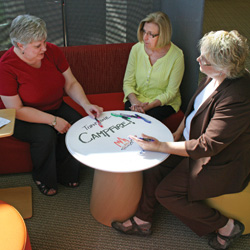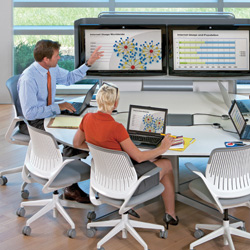
When did work become so complicated and around-the-clock frenetic?
It seems work follows us wherever we go. We work at the office, the coffee shop, home, the beach, the kids’ games or our favorite diner. The new global marketplace means work happens anytime, anywhere and any place.
During the last couple of years, businesses have had to make tough decisions: cost reductions, downsizing and how to get products to market faster. These decisions have changed the workplace. Reduced real estate costs may mean more workers are working in their homes. Downsizing has left fewer employees to get the work done and getting to market faster is just survival. Add to this mix a new generation entering the workforce with ideas of how they want to work and everything changes.
The most recent generation to enter the workforce, the Millennials or Gen Y, is destined to change the workplace as much, if not more, than the Baby Boomers did 40 years ago. This younger generation grew up using technology and believes the workplace will adapt to them. Gen Yers prefer to work in groups and tend to develop social networks more than previous generations. They are accustomed to using mobile devices and digital content. A smartphone and a laptop is all they may need to conduct business.
But before you send everyone out of the office to work, it is important to understand the type of work your employees do. Some workers need to come to the office every day and spend most of their days at their workstations inputting data. Others also come to the office every day, but are mobile-meeting internally with different departments or customers, checking inventory or using resources. Then there are the road warriors—workers who come to the office a few times a week, or those who are rarely seen in the office.
All of these changes mean the workplace has to adapt to the different types of work being conducted in a facility. If you start to view the workplace as an investment and not just as overhead, then it becomes a place where employees can get work done more efficiently. They may move throughout the day to different spaces that support the type of work they are doing. The space may be a quiet corner where they can focus on a project, or a team area where the group meets to brainstorm. Below are some of the emerging trends we are seeing in the workplace today.
 Real Estate Optimization
Real Estate Optimization
Real estate is one of the main assets (and expenses) of a company. In recent years, many companies have reduced the amount of real estate they lease. This does reduce overhead, but does it make for a more efficient workplace? If you have areas that sit idle most of the work week, then it may be time to review if the space is really working for your company, or could it be put to another use? If your employees work in teams but have nowhere to meet and discuss ideas, then the unused conference room may need to be reinvented. Cutting square footage to cut costs may create more problems if your employees don’t have the right type of spaces that enable them to complete their work.
Managing Distributed Employees
Technology has made it easier for employees to work anywhere and stay connected to the workplace. Some employees are no longer expected to be at the office every day. Employees may work at customer sites, on the road or at home. Managing a department has become more challenging these days, especially if the employees are located across town or across the country. Face-to-face meetings with a supervisor are not always possible. Work hours may be adjusted to accommodate conference calls or videoconferencing sessions. The 9-to-5 workday has taken on new meaning in a global marketplace. A telecommuting employee probably doesn’t need their own workstation at the office, especially if the station is empty (not a good use of real estate). However, a telecommuter will need a touchdown space for the occasional day they are in the office.
Managing and Responding to Change
No one likes it, but it is a necessary evil, especially in today’s economy. Change is always affected by human behavior and requires a company to align its culture, values, people, processes, systems and behaviors to encourage and reinforce the new changes. You will need to answer the “What’s in it for me?” question to get buy-in from employees. Communicating the reason for the change, and then communicating again, will ease employee stress. Making sure the workspace provides the necessary tools to reinforce the need for change will give employees a feeling that this may work.
Attract & Retain Employees
Finding top talent is not easy. Today’s workforce is changing: Gen Y is entering the workforce and Baby Boomers are approaching retirement. This mass exodus will leave a large gap in available workers. Yet many Baby Boomers are rethinking their work lives and deciding to stay in the workforce for a few more years, since they’ve seen their retirement nest eggs shrink in recent years. Attracting the next generation of workers will require companies to rethink how they recruit, where they recruit and who they recruit. The workplace culture may be a deciding factor for Gen Yers. They are looking for flexible hours, spaces that inspire creativity and the tools to support their work.
Work Flexibility
Flexibility is the freedom to choose how, when and where to work. Today’s workers are content creators, analyzers and developers who may need different spaces for different tasks. By not restricting people to a single workstation, they have more options, more tools and more empowerment to work productively. Designing a range of work areas within an office allows employees to transition between the different work modes—focused, social, learning and collaborative. Each work mode has unique needs. Collaboration
Collaboration
Business issues are becoming more complex. Collaboration is more important than ever. Sharing information, building on each others’ ideas and talking through a potential solution is never easy and requires time to develop a solution. Collaboration is not limited to meeting rooms, but happens at desks, in hallways, on smartphones or via the Internet. It’s usually spontaneous, versus a planned meeting time. Collaboration takes time as people build the social and informational networks needed to work together effectively, but it is still vital for innovation. Meeting and interacting with coworkers is one of the main reasons people come into the office. Collaboration formalizes the old adage: Two heads (or more) are better than one.
Innovation
Can you afford not to be innovative? Two words describe the need: more and faster. Innovation keeps a company competitive. The workplace should energize and supercharge employees and their creative process. The pressure to keep costs down and keep the organization skinny—doing more with less—is creating a renewed interest in innovation and how to encourage it. Creating the right kinds of spaces help people collaborate, share knowledge, learn and build networks of trust that are critical for solving issues. An individual workstation doesn’t create the fluid energy needed to develop solutions to complex issues. A team space should display works in progress of the team using the space. Allowing employees to transition between individual space and the team space gives them the choice to generate ideas and build on each other’s ideas
before meeting.
Brand
An organization’s brand (who they are and what they stand for) and culture shape and reflect the company. The workspace changes as brand and culture evolve. Companies reflect their brand in public spaces and lobbies in their use of corporate colors and company photographs. But, by recognizing that the entire workspace provides an opportunity to refine and redefine the culture, organizations can respond to changes in the workplace. Why an emphasis on branding? The next generation of workers will be looking for companies that are trusted in the marketplace, bring products to market quickly and believe in letting employees decide how and where to work.
While these are some of the emerging workplace trends we see today, not all companies will be implementing all of them. The first question to ask: How do my employees work, and are they being supported by the workplace, or is it hindering their abilities and productivity?
These trends are interconnected. It would be difficult to try to incorporate a single trend. Trying to create collaborative areas won’t work if most employees are involved in focused work; letting employees work at home won’t work if a supervisor expects to see all of their employees every day. An interconnected, smarter-working workplace builds and fosters employee interactions. It can inspire or frustrate its occupants. The measure of a great workplace—a place where employees trust the people they work for, have pride in what they do and enjoy the people they work with—there’s no greater tool. iBi
» The Four Modes of Work
Focus. A single worker’s ability to concentrate and devote uninterrupted effort to a particular task describes this work mode. Characteristics of this mode are: thinking, reflecting, analyzing, problem solving, creating, imagining, reviewing, assessing and producing work. According to a Gensler study, workers spend an average of 48 percent of their time in focused work.
Collaborate. As work becomes more complex, it requires teams of workers to get projects done. Characteristics of this mode are: working with others to plan, strategize, share knowledge and information, problem-solve, develop, innovate, create and produce work as a team. The Gensler study shows that workers spend approximately 32 percent of their time collaborating. This mode of work is increasing due to the complexity of business issues.
Learn. In today’s business world, highly skilled and knowledgeable workers are critical to business growth and success. Characteristics of this mode are: problem-solving, memorization, concept explanation and development, discovery and reflection, and the ability to integrate and apply the knowledge. According to the Gensler study, most workers spend six percent in learning situations, while at top-performing companies, workers spend up to 46 percent of their time in learning.
Socialize. Socializing is critical to developing and fostering social networks. These networks are the infrastructure that moves knowledge through the organization to create innovation and new ideas. Characteristics of this mode are: interactions that create common bonds and values, collective identity and collegiality, and building trust. According to the Gensler study, workers spend about six percent of their time in social activities. The social aspect of work will become more important to organizational performance as Generation Y workers enter the workforce.
Source: “Working Around the Water Cooler,” by Janet Pogue, Reposted with permission from Employee Benefit News, February 2009, gensler.com.

